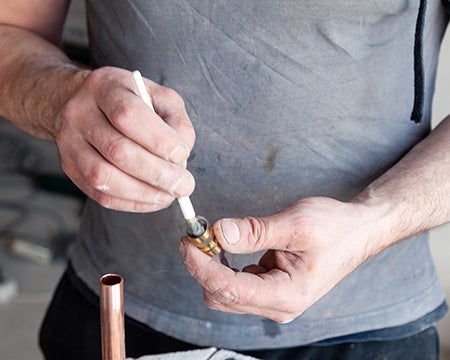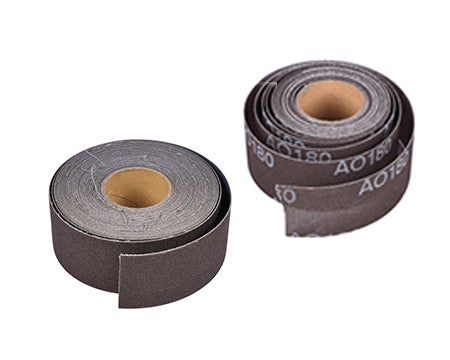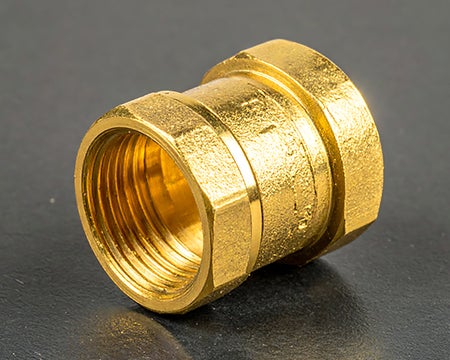Soldering plumbing materials like brass, galvanized steel, chrome-plated fittings, and dissimilar metals demands more care and precision than soldering copper. These materials interact differently with heat, conduct it unevenly, and often include coatings or alloys that affect adhesion. This guide explains how to tackle each of these special-case soldering scenarios—especially brass—to help ensure leak-free, long-lasting joints using the proper techniques and tools.
Why Soldering Special Materials Requires Extra Care
Copper is ideal for soldering because of its excellent heat conductivity and predictability. Brass, galvanized steel, chrome, and dissimilar metals can behave inconsistently when heat is applied. The risk of overheating or underheating is higher, especially when dealing with modern low-lead alloys that don’t conduct heat as well. In these cases, proper surface preparation, using flux, and distributing heat evenly become even more critical to achieving a reliable bond.
Soldering Brass Pipe and Fittings
Brass fittings are commonly found in valves, supply stops, drop-ear elbows, and expansion tank connections. While brass is often soldered to copper pipe, it doesn’t conduct heat as efficiently. This is especially true of low-lead brass, which replaced traditional leaded alloys. Low-lead brass fittings are now the norm for potable water systems, driven by federal regulations like the Safe Drinking Water Act. These fittings contain very low levels of lead (often around 0.25% or less), which makes them safer, but more challenging to solder.
These low-lead alloys require higher heat and more precise technique because they lose heat quickly and are prone to flux burn-off, which leads to poor solder flow and potential leaks.
Tips to expertly solder low-lead brass:
- A tinning flux, like Oatey® No. 95 Tinning Flux, can help compensate for poor heat conductivity. It will also eliminate the human error of soldering brass and fill the joint to create a leak-free connection.
- To reduce the risk of overheating, use a solder with a lower melting point, like Oatey® Safe-Flo®.
- Be patient: Rushing the heat process can lead to flux burnout and leaks.
Why Use Tinning Flux for Brass?
Tinning flux contains finely powdered solder. When heated, it helps pre-coat both surfaces with solder, offering an added layer of protection and helping fill micro-gaps during final soldering. This “insurance policy” is especially useful for:
- Brass pipe and fittings
- Larger-diameter pipe with more surface area
- Dissimilar metals with different heat retention
- Users with less frequent soldering experience
For more tips on soldering step-by-step, visit our complete guide to soldering copper pipes.

Soldering Chrome-Plated or Coated Fittings
Chrome plating resists solder adhesion due to its smooth, nonporous finish. You must roughen the surface (using mesh cloth or sandpaper) to expose the underlying brass for solder to bond correctly.
Best practices when soldering chrome-plated or coated fittings:
- Remove chrome from any surface to be soldered.
- Heat evenly and avoid overheating—chrome discolors easily.
- Limit soldering to non-cosmetic joints where aesthetics aren’t critical.

Soldering Dissimilar Metals (e.g., Brass to Copper)
Soldering brass fittings to copper pipe is common, but heat transfers differently between the two metals, leading to uneven heating and increased risk of leaks. Brass requires more heat, while copper heats faster.
Technique Tips:
- Use tinning flux on both the brass fitting and copper pipe.
- Apply heat evenly to avoid overheating one material while underheating the other.
- Preheat the copper slightly to help balance the heat transfer.
Soldering is not recommended when working with brass-to-brass pipe connections. Instead, these connections should be made using mechanical (threaded) fittings.
When to Consider Mechanical Fittings Instead
Mechanical (threaded) fittings are a better option in certain cases:
- Brass pipe-to-brass pipe connections
- Repair scenarios involving galvanized pipe
- Situations where future disassembly may be needed
Threaded joints offer convenience and reliability, especially where soldering would be too risky or difficult due to water in the line or inaccessible locations.

Frequently Asked Questions
-
Why is it harder to solder brass than copper?
-
Brass, especially low-lead brass, doesn’t conduct heat as well as copper. This makes it easier to overheat or underheat during soldering, which can lead to leaks.
-
-
Can you solder brass to copper?
-
Yes, but be aware of the different heating rates. Use tinning flux and apply heat evenly to prevent flux burn-off.
-
-
What flux should you use for brass?
-
Oatey® No. 95 Tinning Flux is ideal. It contains powdered solder to help ensure better flow and joint integrity.
-
-
Can you solder galvanized pipe?
-
Technically, yes, but it’s rare, potentially hazardous, and unsuitable for potable water systems. Mechanical fittings are typically recommended instead.
-